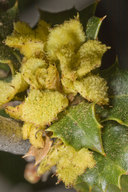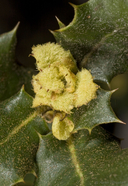notes Something strange seemed to be going on with the new leaves growing at the branch tips of this Palmer's Oak...with unusually dense & bright-golden pubescence & 'scurf' emanating from the abaxial leaf surfaces. If this were due to an arthropod gall-inducer, I'd guess there'd be some more conspicuous, localized, larval-chamber swelling visible in (or on) the leaf...though perhaps tiny mites might be involved? Or maybe this was caused by a fungal, viral, or bacterial infection? Or perhaps Quercus palmeri prefers relatively xeric conditions and the tree was reacting to the high precipitation of the year by growing its underside leaf tomentum with unusually robust zeal?
______ Further Info on Palmer's Oak ___________________
Quercus palmeri takes 2 years for its acorns to grow & mature, and all we could find on this tree were small 1st year acorns...which lack the thick outwardedly flared acorn cap rim that is so distinctive for this species. So it wasn't immediately obvious to me that this was Q. palmeri...but David Styer, who provided the ID, knows the particular tree here well (it's actually thought to be part of a single large clone), and there's a photo of the distinctive acorn cap on pg. 129 of his 2019 'Flora of Fort Ord'.
Quercus palmeri is a rare & fascinating species. It is found in widely-scattered and relatively-isolated stands in CA & AZ where it usually grows as low, densely-shrubby, clonal colonies. They are thought to be relicts, with one clone estimated to be over 13,000 years old (see short news article here, or more detailed paper here). This Fort Ord clone is fairly large and presumably quite old. The population here may also be the lowest elevation & closest known station to the ocean...and its substrate may be among the sandiest for this species.


